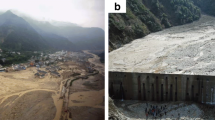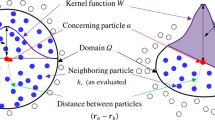Abstract
Noxious atmospheric releases may originate from both accidents and malicious activities. They are a major concern for public authorities or first responders who may wish to have the most accurate situational awareness. Nonetheless, it is difficult to reliably and accurately model the flow, transport, and dispersion processes in large complex built-up environments in a limited amount of time and resources compatible with operational needs. The parallel version of Micro-SWIFT-SPRAY (PMSS) is an attempt to propose a physically sound and fast response modelling system applicable to complicated industrial or urban sites in case of a hazardous release. This paper presents and justifies the choice of the diagnostic flow and Lagrangian dispersion models in PMSS. Then, it documents in detail the development of the parallel algorithms used to reduce the computational time of the models. Finally, the paper emphasizes the preliminary model validation and parallel performances of PMSS based on data from both wind tunnel (Evaluation of Model Uncertainty) and in-field reduced-scale (Mock Urban Setting Test) and real-scale (Oklahoma City) experimental campaigns.














Similar content being viewed by others
References
Allwine KJ, Clawson KL, Flaherty JE, Heiser JH, Hosker RP, Leach MJ, Stockham LW (2007) Urban dispersion program: urban measurements applied to emergency response. In: Seventh symposium on the urban environment, American meteorological society, vol 5, San Diego (CA), USA, September 2007
Allwine KJ, Leach MJ, Stockham LW, Shinn JS, Hosker RP, BowersJF, Pace JC (2004) Overview of joint urban 2003: an atmospheric dispersion study in Oklahoma City. In: Preprints of the symposium on planning, nowcasting and forecasting in the urban zone, American meteorological society, CD-ROM J, vol 7, Seattle (WA), USA, January 2004
Allwine KJ, Shinn JH, Streit GE, Clawson KL, Brown M (2002) Overview of urban 2000: a multiscale field study of dispersion through an urban environment. Bull Am Meteorol Soc 83(4):521–536
Biltoft CA, Yee E, Jones CD (2002) Overview of the Mock Urban Setting Test (MUST). In: Proceedings of the fourth symposium on the urban environment, May 2002, 20–24
Boris J, Fulton JE Jr, Obenschain K, Patnaik G, Young T Jr (2004) CT-analyst: fast and accurate CBR emergency assessment. In: Defense and security. International society for optics and photonics, pp 1–13
Brook DR, Felton NV, Clem CM, Strickland DCH, Griffiths IH, Kingdon RD, Hall DJ, Hargrave JM (2003) Validation of the urban dispersion model (UDM). Int J Environ Pollut 20(1–6):11–21
Brown MJ, Williams M (1998) An urban canopy parameterization for mesoscale meteorological models. In: Proceedings of the AMS conference on second urban environment symposium, November 1998, 2–7
Camelli FE, Hanna SR, Lohner R (2004) Simulation of the MUST field experiment using the FEFLO-urban CFD model. In: Fifth symposium on the urban environment, American meteorological society, CD-ROM 13.12, Vancouver (BC), Canada
Carissimo B, Macdonald RW (2002) A porosity/drag approach for the modeling of flow and dispersion in the urban canopy. In: Air pollution modeling and its application XV, Springer International Publishing, pp 385–393
Danzig R, Sageman M, Leighton T, Hough L, Yuki H, Kotani R, Hosford ZM (2011) Aum Shinrikyo—insights into how terrorists develop biological and chemical weapons. Center for a New American Society, July 2011
Gowardhan AA, Pardyjak ER, Senocak I, Brown MJ (2011) A CFD-based wind solver for an urban fast response transport and dispersion model. Environ Fluid Mech 11:439–464
Gowardhan AA, Pardyjak ER, Senocak I, Brown MJ (2007) Investigation of Reynolds stresses in a 3D idealized urban area using large eddy simulation. In: Proceedings of the AMS seventh symposium on urban environment, San Diego (CA), USA, paper J12.2
Hall RC (1997) Evaluation of model uncertainty (EMU)—CFD modelling of near-field atmospheric dispersion. Project EMU final report to the European Commission (Data CD also available with report), vol 7, WS Atkins Doc No. WSA/AM5017
Hanna SR, Chang JC (2012) Acceptance criteria for urban dispersion model evaluation. Meteorol Atmos Phys 116:133–146
Hanna S, Chang J, Hearn J, Hicks B, Fox S, Whitmire M, Spicer T, Brown D, Sohn M, Yamada T (2016) Deposition following accidental releases of chlorine from railcars. In: Air pollution modeling and its application XXIV, Springer International Publishing, pp 377–383
Hanna S, White J, Trolier J, Vernot R, Brown M, Gowardhan A, Kaplan H, Alexander Y, Moussafir J, Wang Y, Williamson C (2011) Comparisons of JU2003 observations with four diagnostic urban wind flow and Lagrangian particle dispersion models. Atmos Environ 45(24):4073–4081
Hill MD, Marty MR (2008) Amdahl’s law in the multicore era
Holmes NS, Morawska L (2006) A review of dispersion modelling and its application to the dispersion of particles: an overview of different dispersion models available. Atmos Environ 40(30):5902–5928
Hosker RP Jr (1984) Flow and diffusion near obstacles. In: Randerson D (ed) Atmospheric science and power production, DOE/TIC-27601, US Department of Energy, Washington DC, Ch. 7, pp 241–326
Kaplan H, Dinar N (1996) A Lagrangian dispersion model for calculating concentration distribution within a built-up domain. Atmos Environ 30(24):4197–4207
Leitl B, Trini Castelli S, Baumann-Stanzer K, Reisin TG, Barmpas Ph, Balczo M, Andronopoulos S, Armand P, Jurcakova K, Milliez M (2014) Evaluation of air pollution models for their use in emergency response tools in built environments: the ‘Michelstadt’ Case study in COST ES1006 action. In: Air pollution modeling and its application XXIII, Springer International Publishing, pp 395–399
Macdonald RW (2000) Modelling the mean velocity profile in the urban canopy layer. Bound-Layer Meteorol 97(1):25–45
McHugh CA, Carruthers DJ, Edmunds HA (1997) ADMS-urban: an air quality management system for traffic, domestic and industrial pollution. Int J Environ Pollut 8:666–674
Moussafir J, Oldrini O, Tinarelli G, Sontowsky J, Dougherty C (2004) A new operational approach to deal with dispersion around obstacles: the MSS software suite. In: Nineth international conference on harmonization within atmospheric dispersion modeling for regulatory purposes
Moussafir J, Olry C, Tinarelli G, Oldrini O, Harris T (2008) SWIFT and MSS current development. In: Twelfth annual George Mason University transport and dispersion modeling workshop
Patnaik G, Boris JP, Grinstein FF, Iselin JP (2003) Large scale urban simulation with the MILES approach. In: Annual AIAA CFD conference, AIAA paper 2003-4104, Orlando (FL), USA
Röckle R (1990) Bestimmung der Strömungsverhältnisse im Bereich komplexer Bebauungsstrukturen. PhD dissertation, Darmstadt, Germany
Rodean HC (1996) Stochastic lagrangian models of turbulent diffusion. American meteorological society, vol 45, Boston, USA
Sarrat C, Lemonsu A, Masson V, Guedalia D (2006) Impact of urban heat island on regional atmospheric pollution. Atmos Environ 40(10):1743–1758
Schulman LL, Strimaitis DG, Scire JS (2000) Development and evaluation of the PRIME plume rise and building downwash model. J Air Waste Manag Assoc 50(3):378–390
Smith WS, Brown MJ (2002) A CFD-generated wind field library feasibility study: maximum wind direction interval. In: Fourth symposium on the urban environment, May 2002, pp 196–197
Soulhac L, Salizzoni P, Cierco FX, Perkins R (2011) The model SIRANE for atmospheric urban pollutant dispersion—part I: presentation of the model. Atmos Environ 45(39):7379–7395
Sykes RI, Parker SF, Henn DS, Cerasoli CP, Santos LP (2000) PC-SCIPUFF version 1.3 technical documentation. ARAP Report No. 725. Titan Corporation, ARAP Group
Thomson DJ (1987) Criteria for the selection of stochastic models of particle trajectories in turbulent flows. J Fluid Mech 180:529–556
Tinarelli G, Brusasca G, Oldrini O, Anfossi D, Trini Castelli S, Moussafir J (2007) Micro-SWIFT-SPRAY (MSS): a new modelling system for the simulation of dispersion at microscale—general description and validation. In: Air pollution modeling and its application XVII. Springer International Publishing, pp 449–458
Tinarelli G, Mortarini L, Trini Castelli S, Carlino G, Moussafir J, Olry C, Armand P, Anfossi D (2013) Review and validation of Micro-SPRAY, a lagrangian particle model of turbulent dispersion. In: Lagrangian modeling of the atmosphere, geophysical monograph, vol 200, American Geophysical Union (AGU), May 2013, pp 311–328
Yee E, Lien FS, Ji H (2010) A building-resolved wind field library for vancouver: facilitating CBRN emergency response for the 2010 winter olympic games. Defense Research and Development, DRDC-Suffield-TM-2010-088, Suffield (AB), Canada
Author information
Authors and Affiliations
Corresponding author
Rights and permissions
About this article
Cite this article
Oldrini, O., Armand, P., Duchenne, C. et al. Description and preliminary validation of the PMSS fast response parallel atmospheric flow and dispersion solver in complex built-up areas. Environ Fluid Mech 17, 997–1014 (2017). https://doi.org/10.1007/s10652-017-9532-1
Received:
Accepted:
Published:
Issue Date:
DOI: https://doi.org/10.1007/s10652-017-9532-1




